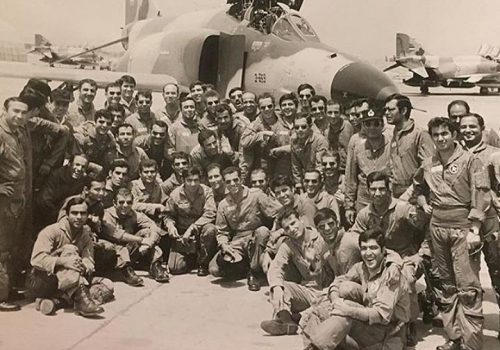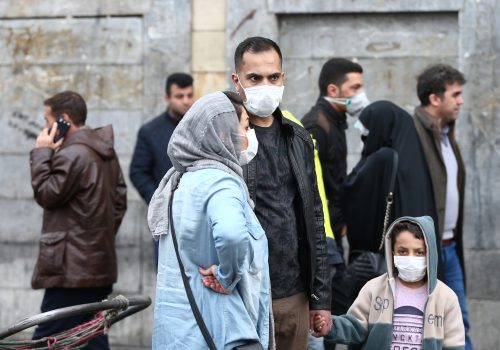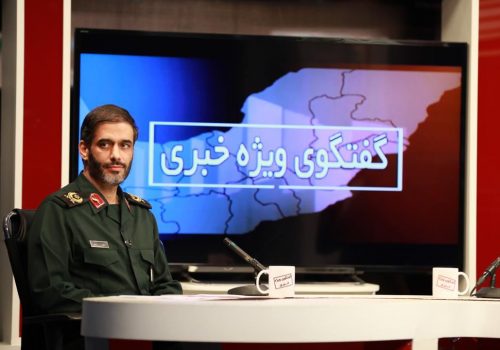How Iranian Phantoms pulled off one of the most daring airstrikes in recent memory
Nothing captures the irony and troubling nature of the Islamic Republic’s relationship with its regular armed forces—known as Artesh—like the mistreatment of its officers and Non- Commissioned Officers (NCOs). This is despite Artesh—in particular the Iranian Air Force—utilizing its superb training and modern equipment—acquired during Mohammad Reza Pahlavi’s monarchy—to turn the tide of the war with Iraq in 1981 and the achievement of Iran’s first strategic successes during the bloody eight-year war (1980-1988). The daring airstrike on the Al-Walid airbases (known as H-3 after the three bases in southwestern Iraq, near the Jordanian border) came to be known as “Attack on H-3,” which later became title of a movie more than a decade later.
On April 6, 1981, a group of Islamic Republic of Iran Air Force (IRIAF) fighter pilots, officers, and NCOs gathered to meet with the founder of the Islamic Republic, Supreme Leader Ayatollah Ruhollah Khomeini. The meeting was a recognition of their courage in completing one of the boldest raids in the history of modern air warfare. Only two days earlier on April 4, eight F-4 Phantom fighter bombers commanded by Major Farajollah Baratpour took off from the third Tactical Airbase (TAB) in the northwestern city of Hamadan. They successfully attacked and destroyed three airbases deep inside Iraqi territory.
It was the highest honor anyone could have asked for at the time. As the officers gathered to meet Khomeini, the presence of then Colonel Bahram Hoshyar was noticeable. He was the man who came up with the extraordinary plan to reach the furthest points in western Iraq.
Like many of his fellow officers, Hoshyar, a highly trained officer from the Pahlavi era, had been previously arrested on suspicion of disloyalty to the new regime, only to be later allowed to return to service. He had been among the first group of Iranian pilots trained on F-4 Phantom fighter aircraft and was also a member of the Taj-e Talayi (Golden Crown) Aerobatics team—the equivalent of the US Air Force’s Thunderbirds. Meanwhile, its founder General Nader Jahanbani, was summarily executed a few weeks into the new regime on March 13, 1979. Jahanbani had overseen the training of many of those who had gathered that day during the Pahlavi era. The purges and executions deprived IRIAF of its most experienced commanders and personnel.
Iranian military commanders realized early in the war that they needed air superiority against Iraqi forces to recapture their lost territories. Brigadier General (Ret.) Ali Sabounchi, then a major, remembers a conversation with Colonel Javad Fakouri, commander of the IRIAF and National Defense Minister, early in the war. “[Fakouri] told me that we had to attack Al-Walid airbase, we had to gain the upper hand.” Planning started in earnest, but the task was not easy. Sabounchi adds that they tried twice but were forced to abort for security reasons. Upon returning to service, Hoshyar was appointed as the head of IRIAF’s Electronic Warfare Group. Later, the head of air force operations, Colonel Mahmoud Gheydeyan, tasked Hoshyar with creating a group to discuss and plan strategic operations with another officer, Colonel Fereydoun Izadseta. It was there that two officers came up with the plan to simultaneously attack all three Al-Walid air bases (H-3).
The cluster of airbases that hosted the majority of the Iraqi air force fleet in the western Al-Anbar governorate was designed to keep Iraqi aircraft as far away as possible from the Iranian borders, making it impossible for Iranians to attack them. In this regard, Brigadier General (Ret.) Manouchehr Tousi of the Iranian air force compares the ability to attack these airbases to throwing the first punch in a match.
The operation’s final plan called for coordinated and simultaneous attacks requiring the use of various elements from air cover to aerial refueling, totaling nearly five hours of combat. Meanwhile, to achieve their objective, Iranian officers had to deal with several planning issues. For one, to reach their destination, the heavily armed Iranian Phantoms had to fly three thousand kilometers at a very low level to reach their targets undetected by Iraqi air defense systems. This would require four mid-air refuelings using large air tankers flying at a very low level—not higher than 150 feet. Colonel (Ret.) Luther Yadegarian, an Assyrian-Iranian officer and a Boeing 707 fuel tanker pilot, who performed the first mid-air refueling over Iran’s Lake Urmia at a very low altitude, notes: “There was nothing but brotherhood among us, we all came together in defense of our homeland.” He added, “It was the most difficult thing I ever did with low visibility.”
To reach Al-Walid undetected, Iranian fighter pilots flew their American-made F-4E Phantoms over snow-covered mountains of Iraqi Kurdistan into its western desert. Brigadier General Tousi (then a Major) who participated in the operation, explains: “Flying over the snow-covered mountains at 150 feet felt like as [if] we were skiing.” In addition to the refueling problem was that the second refueling rendezvous was on the Iraqi-Turkish border. Tousi comments that “We didn’t know if the tankers would be there…We weren’t even sure if our fuel would be enough to take us to the rally point. If we missed our tankers, the entire mission would have failed disastrously.”
Furthermore, the heavily armed Phantoms were completely vulnerable to the Iraqi air defense forces. To provide air cover, two F-14A Tomcats—with their state-of-the-art radars—patrolled Iran’s western borders, keeping an eye out for potential threats to the strike group. IRIAF command had also deployed a Lockheed C-130H early warning aircraft (known as Khofaash or Bat) and a Boeing 747 airborne command to monitor Iraqi communications to avoid any detection. Finally, to distract enemy radars, three F-5E fighter planes from the 2nd Tactical Airbase in the northwestern city of Tabriz attacked an Iraqi airbase near Kirkuk in northern Iraq as a diversionary measure.
The preparations and careful planning paid off. When IRIAF fighter bomber planes arrived over their targets deep inside Iraqi territory, they caught the Iraqis entirely by surprise. Iran’s Joint Chiefs of Staff later claimed that IRIAF pilots had destroyed forty-eight Iraqi aircraft on the ground. While Iraqi sources have denied these claims, Tom Cooper, an Austrian aerial warfare analyst and historian, notes that the Iranian air force destroyed a total of three transport An-12BPs, one Tu-16 Bomber, four MIG-21s, five SU-20/22s, eight MIG-23s, and four helicopters. The strike guaranteed the success of ground operations that would follow later that year to recapture the lost territory, climaxing in the spring of 1982 by the liberation of the strategic port city of Khorramshahr in the southwest. For the first time since the outbreak of the war, the Islamic Republic of Iran Broadcasting (IRIB) played a victory march song composed during the monarchy.
The meeting with the Supreme Leader on April 6 was a reward and an acknowledgement of the IRIAF’s extraordinary achievement. However, the jubilation was short-lived. According to Colonel (Ret.) Ebrahim Pourdan, the IRIB later refused to broadcast an interview with the participating pilots because they had not started their comments with “In the name of God”—a sign of devotion to Islam and the nascent Islamic Republic. Political tensions in the following summer would overshadow Artesh and IRIAF achievements further. The rift between the leftist and fundamentalist parties was fought violently on the streets of Tehran. The fundamentalists became increasingly vocal in their criticism of liberal-minded first President Abolhassan Banisadr of the nascent Islamic Republic, who was the commander-in-chief and relied heavily on Artesh to conduct the war efforts.
Following the impeachment of President Banisadr and his escape in the summer of 1981 into France onboard a hijacked IRIAF aircraft, Colonel Fakouri had to resign from his posts. Some other participating officers were forced into early retirement or simply purged from the air force. Despite their courage and patriotism, the men and women of IRIAF never gained the political establishment’s trust, where ideology and politics comes first.
Sina Azodi is a nonresident fellow at the Atlantic Council and a visiting scholar at the George Washington University’s Institute for Middle East Studies. He is also a PhD Candidate in International Relations at University of South Florida. Follow him on Twitter @Azodiac83.
Ali Dadpay is an associate professor of finance at the Gupta College of Business at the University of Dallas in Texas. Follow him on Twitter: @adadpay.
Image: After meeting with Iran’s Supreme Leader, Col. Qasem Golchin, Colonel Javad Fakouri, and First Lt. Ebrahim Pourdan speak to IRIB journalist. (Courtesy photo)


